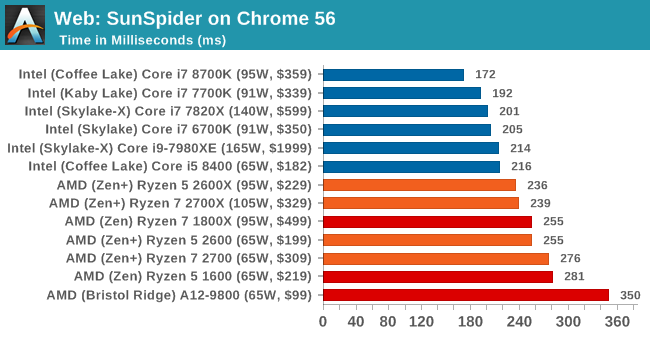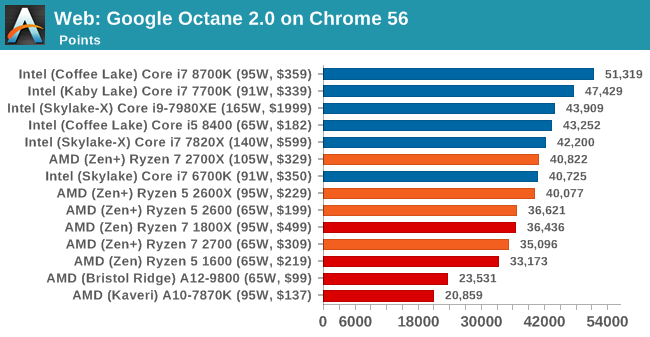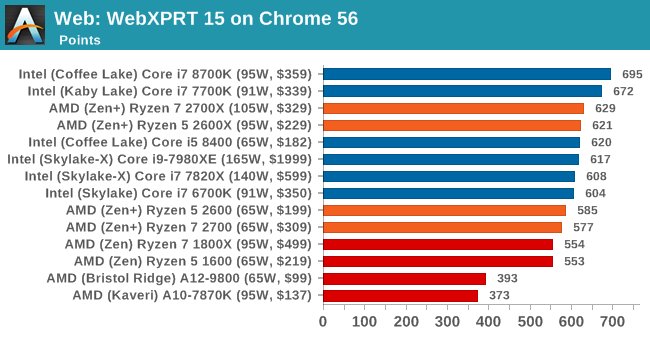The AMD 2nd Gen Ryzen Deep Dive: The 2700X, 2700, 2600X, and 2600 Tested
by Ian Cutress on April 19, 2018 9:00 AM ESTCPU Web Tests
One of the issues when running web-based tests is the nature of modern browsers to automatically install updates. This means any sustained period of benchmarking will invariably fall foul of the 'it's updated beyond the state of comparison' rule, especially when browsers will update if you give them half a second to think about it. Despite this, we were able to find a series of commands to create an un-updatable version of Chrome 56 for our 2017 test suite. While this means we might not be on the bleeding edge of the latest browser, it makes the scores between CPUs comparable.
All of our benchmark results can also be found in our benchmark engine, Bench.
SunSpider 1.0.2: link
The oldest web-based benchmark in this portion of our test is SunSpider. This is a very basic javascript algorithm tool, and ends up being more a measure of IPC and latency than anything else, with most high-performance CPUs scoring around about the same. The basic test is looped 10 times and the average taken. We run the basic test 4 times.

Mozilla Kraken 1.1: link
Kraken is another Javascript based benchmark, using the same test harness as SunSpider, but focusing on more stringent real-world use cases and libraries, such as audio processing and image filters. Again, the basic test is looped ten times, and we run the basic test four times.

Google Octane 2.0: link
Along with Mozilla, as Google is a major browser developer, having peak JS performance is typically a critical asset when comparing against the other OS developers. In the same way that SunSpider is a very early JS benchmark, and Kraken is a bit newer, Octane aims to be more relevant to real workloads, especially in power constrained devices such as smartphones and tablets.

WebXPRT 2015: link
While the previous three benchmarks do calculations in the background and represent a score, WebXPRT is designed to be a better interpretation of visual workloads that a professional user might have, such as browser based applications, graphing, image editing, sort/analysis, scientific analysis and financial tools.











545 Comments
View All Comments
YukaKun - Saturday, April 21, 2018 - link
Oh, I'm actually curious about your experience with all the systems.I'm still running my i7 2700K at ~4.6Ghz. I do agree I haven't felt that it's a ~2012 CPU and it does everything pretty damn well still, but I'd like to know if you have noticed a difference between the new AMD and your Sandy Bridge. Same for when you assemble the 2700X.
I'm trying to find an excuse to get the 2700X, but I just can't find one, haha.
Cheers!
Luckz - Monday, April 23, 2018 - link
The the once in a lifetime chance to largely keep your CPU name (2700K => 2700X) should be all the excuse you need.YukaKun - Monday, April 23, 2018 - link
That is so incredibly superficial and dumb... I love it!Cheers!
mapesdhs - Monday, April 23, 2018 - link
YukaKun, your 2700K is only at 4.6? Deary me, should be 5.0 and proud, doable with just a basic TRUE and one fan. 8) For reference btw, a 2700K at 5GHz gives the same threaded performance as a 6700K at stock.And I made a typo in my earlier reply, mentioned the wrong XEON model, should have been the 2680 V2.
YukaKun - Tuesday, April 24, 2018 - link
For daily usage and stability, I found that 4.6Ghz worked best in terms of noise/heat/power ratios.I also did not disable any power saving features, so it does not work unnecessarily when not under heavy load.
I'm using AS5 with a TT Frio (the original one) on top, so it's whisper quiet at 4.6Ghz and I like it like that. When I made it work at 5Ghz, I found I had to have the fans near 100%, so it wasn't something I'd like, TBH.
But, all of this to say: yes, I've done it, but settled with 4.6Ghz.
Cheers!
mapesdhs - Friday, March 29, 2019 - link
(an old thread, but in case someone comes across it...)I use dynamic vcore so I still get the clock/voltage drops when idle. I'm using a Corsair H80 with 2x NDS 120mm PWM, so also quiet even at full load; no need for such OTT cooling to handle the load heat, but using an H80 means one can have low noise aswell. An ironic advantage of the lower thermal density of the older process sizes. Modern CPUs with the same TDP dump it out in a smaller area, making it more difficult to keep cool.
Having said that, I've been recently pondering an upgrade to have much better general idle power draw and a decent bump for threaded performance. Considering a Ryzem 5 2600 or 7 2700, but might wait for Zen2, not sure yet.
moozooh - Sunday, April 22, 2018 - link
No, it might have to do with the fact that the 8350K has 1.5x the cache size and beastly per-thread performance that is also sustained at all times—so it doesn't have to switch from a lower-powered state (which the older CPUs were slower at), nor does it taper off as other cores get loaded, which is most noticeable on the the things Samus mentioned, ie. "boot times, app launches and gaming". Boot times and app launches are both essentially single-thread tasks with no prior context, and gaming is where a CPU upgrade like that will improve worst-case scenarios by at least an order of magnitude, which is really what's most noticeable.For instance, if your monitor is 60Hz and your average framerate is 70, you won't notice the difference between 60 and 70—you will only notice the time spent under 60. Even a mildly overclocked 8350K is still the one of best gaming CPUs for this reason, easily rivaling or outperforming previous-gen Ryzens in most cases and often being on par with the much more expensive 8700K where thread count isn't as important as per-thread performance for responsiveness and eliminating stutters. When pushed to or above 5 GHz, I'm reasonably certain it will still give many of the newer, more expensive chips, a run for their money.
spdragoo - Friday, April 20, 2018 - link
Memory prices? Memory prices are still pretty much the way they've always been:-- faster memory costs (a little) more than slower memory
-- larger memory sticks/kits cost (a little) more than smaller sticks/kits
-- last-gen RAM (DDR3) is (very slightly) cheaper than current-gen RAM (DDR4)
I suppose you can wait 5 billion years for the Sun to fade out, at which point all RAM (or whatever has replaced it by then) will have the same cost ($0...since no one will be around to buy or sell it)...but I don't think you need to worry about that.
Ferrari_Freak - Friday, April 20, 2018 - link
You didn't write anything about price there... All you've said is that relative pricing for things is the same it has always been, and that's no surprise.The $$$ cost of any give stick is more than it was a year or two ago. 2x8gb DDR4-3200 G.Skill Ripjaws V is $180 on Newegg today. It was $80 two years ago. Clearly not the way they've always been...
James5mith - Friday, April 20, 2018 - link
2x16GB Crucial DDR4-2400 SO-DIMM kit.https://www.amazon.com/gp/product/B019FRCV9G/
November 29th 2016 (when I purchased): $172
Current Amazon price for exact same kit: $329